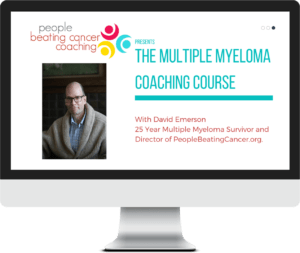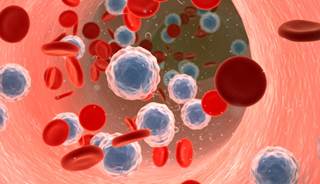Can you live a normal life with myeloma? Understanding the best of both conventional and non-conventional multiple myeloma therapies allows you to live “the new normal.”
A diagnosis of any cancer, especially a rare blood cancer such as multiple myeloma, is life-changing. While the average prognosis for multiple myeloma is limited, I think my experience opens the door to consider more than the conventional standard-of-care therapies for MM patients.
If you want your myeloma prognosis to go beyond the statistical averages, consider both conventional/traditional therapies as well as evidence-based non-conventional therapies.
I hadn’t even heard of a cancer called multiple myeloma when my oncologist gave me the bad news. I had been living with a pain in my neck for several months leading up to my multiple myeloma diagnosis.
Multiple myeloma symptoms, chemotherapy regimens, a bone marrow transplant — I knew nothing about these things. I had a lot to learn…understanding multiple myeloma is a critical first step in your prognosis.
Average life expectancies are currently 5-7 years with 55% of newly diagnosed multiple myeloma patients living for five years. However, newly diagnosed patients with early stage multiple myeloma (stage 1) achieve a five-year survival rate of more than 77%.
The point of these statistics is that there is variability in the newly diagnosed myeloma patient’s prognosis.
Currently there is no cure for multiple myeloma. In my experience, combining the best of both conventional and non-conventional therapies can improve your prognosis for multiple myeloma and quality of life.
The average prognosis for multiple myeloma patients will be remissions and relapses over a period of 5-7 years. It is possible to experience a first remission of 2-3 years followed by a series of shorter relapses and remissions.
Experience has taught me that it is essential to learn as much as you can about your multiple myeloma if your goal is to live the best possible quantity of life as well as quality of life. This is your new normal life with multiple myeloma.
Every decision you make in the coming years about you and your cancer will depend on understanding your multiple myeloma. As the saying goes, knowledge is power.

This post is the gateway to the hundreds of studies coupled with my patient experiences cataloged on PeopleBeatingCancer. I researched and created the Multiple Myeloma Cancer Coaching Program in order to provide multiple myeloma patients with an evidence-based, step by step program to learn about their cancer.
I am a long-term multiple myeloma survivor and cancer coach. I research and write about all things multiple myeloma. PeopleBeatingCancer is dedicated to providing the experience and research needed to manage your multiple myeloma.
I work with newly diagnosed multiple myeloma patients, patients who have relapsed, and online groups. I also administer a private multiple myeloma group called Beating Myeloma.
Have you been living with bone or joint pain for a while now? Have you had a skin rash or nerve pain and not understood why? Or maybe you’ve been mis-diagnosed? Bone, joint, skin, and nerve pain are several of the more common multiple myeloma symptoms. That is to say, these are some of the health problems caused by monoclonal proteins before you are diagnosed with multiple myeloma.
Multiple myeloma is notoriously difficult to diagnose. Therefore, many tests examining your blood, urine, and even your bone marrow are used to determine if you have multiple myeloma. If you do, your stage at diagnosis is determined by your diagnostic criteria.
Multiple myeloma diagnostic criteria go by the acronym CRAB:
- Calcium — A test called a Comprehensive Metabolic Panel will measure calcium in your blood (serum).
- Renal — This same test will measure how your kidneys (renal) are working.
- Anemia — A test called Complete Blood Count will measure your red and white blood cells to see if you are living with anemia and are experiencing fatigue.
- Bone — Imaging studies such as X-rays, MRI, PET scans, or CT scans can look inside your bones to determine if you have lytic lesions (MM) growing in your bones.
In addition, you will probably also undergo a serum protein electrophoresis test (SPEP), an Immunofixation test, a Freelight Chain test, a bone marrow biopsy, a Fluorescence in situ hybridization (FISH) test, and possibly others. As I say, multiple myeloma is difficult to diagnose. Thorough diagnostic testing is your most important first step to managing your MM for the rest of your life.
Staging your diagnosis of multiple myeloma is the second important step for managing your cancer. Multiple myeloma has only three (3) stages: I, II, and III. According to research, 95% of all newly diagnosed patients are stage 2 or 3.
Multiple Myeloma Conventional Therapies

When I use the phrase “conventional therapies,” I am talking about those treatments that have been researched and approved by the Food and Drug Administration (FDA). They are surgery, chemotherapy, and radiation.
Your Board-certified Oncologist will prescribe only FDA-approved therapies to treat your multiple myeloma. Whether you are newly diagnosed or have relapsed, you will undergo surgery, chemotherapy, and/or radiation to treat your multiple myeloma.
FDA approved treatments (the standard-of-care for multiple myeloma):
- Chemo for multiple myeloma- NDMM patients should understand the basics of their myeloma treatment now and in the future
- First Line Treatment — Induction therapy is designed to reduce the NDMM patient’s multiple myeloma as much as possible in preparation for an autologous stem cell transplant.
- Autologous Stem Cell Transplant — Killing your old immune system and growing a new immune system using your own stem cells.
- Maintenance Chemotherapy — Undergoing low-dose chemotherapy in order to remain in remission for as long as possible.
Multiple Myeloma Response Criteria & Response to Treatment
The reason why you are undergoing toxic therapy for your newly diagnosed multiple myeloma is to stabilize your disease. How you respond to treatment is referred to as “response criteria” or your “response to treatment.”
Your overall goal will be to walk a fine line between the damage done to your body by your plasma cells (MM) and the damage done to your body done by toxic conventional therapies.
- Your formal response criteria measures how you respond to treatment.
- How you respond to treatment can guide your future treatment decisions.
Undergo regular diagnostic testing in order to learn if you have reached:
All newly diagnosed multiple myeloma patients want to get rid of all of their cancer ( monoclonal proteins-multiple myeloma- in their bone marrow.
Unfortunately, no one responds 100% to treatment. Even the most complete response possible — MRD (-) — means that there are 4 monoclonal proteins for every one million normal cells.
Multiple Myeloma Side Effects
Most of us know about common short-term side effects of cancer therapies. Think nausea, fatigue, hair loss. Hopefully all are temporary health problems. Though I don’t think oncology does a good job of educating the multiple myeloma patient about long-term side effects of treatment, I think treatment-related side effects must be included in the discussion about your multiple myeloma treatment plan.
Multiple Myeloma Non-Conventional Therapies
All multiple myeloma therapies that I refer to as non-conventional therapies are those treatments that have not been researched and approved by the Food and Drug Administration. This isn’t necessarily a bad thing. The FDA doesn’t approve nutritional supplementation for example.
While there are thousands of studies touting the health benefits of exercise for the multiple myeloma patient, for example, you will never see the FDA approve exercise for treatment.
Since I achieved complete remission from my multiple myeloma in April of 1999, I have researched and written about evidence-based non-conventional therapies such as:
These are just some of those therapies that I define as evidence-based but non-conventional.
You can learn more about my journey here. If you’d like to get a more personalized approach to managing your cancer, I encourage you to sign up for my multiple myeloma coaching program. If you have any other questions, would like to contribute, or otherwise get involved, you can reach out to us here.
David Emerson
- Multiple Myeloma Survivor
- Multiple Myeloma Cancer Coach
- Director PeopleBeatingCancer





